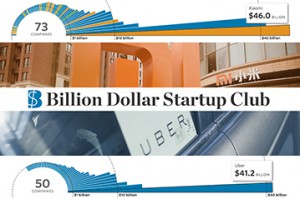Business Model
Following the bulls to the bubble?
The billion dollar start up club.
I found this interesting graphic on the Wall Street Journal that got me thinking about start up funding today.
The start up boom is still in full swing and it seems like every time we turn around we are introduced to another billion dollar plus start up. Which begs the questions, are we on our way to the next bubble? Is Uber (valued at $41.2 billion) really worth more then Sony? Is Snapchat, a company that is still not sure how it’s going to make money really worth $15 billion? Are the venture capitalists brilliant or insane?
I don’t believe anyone is sure of the answers to these questions and with so much money on the line it is a safe bet that an army of people are out there somewhere doing the due diligence before handing out capital. I understand that money isn’t just being slung at everyone with a latte and an idea. Indeed start ups are on average getting older and more mature before they head out for a cycle of funding.Yet despite that the spiraling increases in valuation are worrying, they must reach a ceiling at some point. As venture capitalist are still bullish on start ups though its hard to tell if we are in sight of the ceiling yet or still far away.
Here is the article. Are we in the bubble?
NBCUniversal Redirects IT Focus to Innovation
Atish Banerjea, CIO at NBCUniversal, talks about his experience in improving IT’s image and performance at NBCUniversal. Banerjea states that IT just played a back office role at NBCUniversal. His goal was to move IT from the back office into business unit leadership. The first hurdle was the lack of investment for IT. Banerjea was able to gain support from Comcast, who recently acquired NBCU. Comcast gave capital to allow IT to invest in infrastructure and IT talent. He decided to make improvements where employees would notice changes. This included increasing email capacity, upgrading mobile and desktop devices, and improving the help desk. The most important move that Banerjea did was embedding CIO’s into the business units. This has allowed IT to create support for business units, and offer value from a business perspective.
Do you think embedding CIOs into business units is a good model or do you think they should be a separate entity?
What else do you think Banerja could do to improve IT at NBCUniversal?
Unsustainable Business Models: They Skip the “Search” Phase
In this blog post on Strategyzer, Nabila Amarsy outlines the 3 essential requirements to make a business venture successful:
- The Right Value Proposition
- The Right Business Model
- Flawless Execution
This might seem like common sense, but Amarsy goes on to define what she calls the “search” phase of developing a business idea and how its absence lies at the root of many unsuccessful business ventures. The “search” phase takes place in conjunction with the first 2 requirements outlined above, and basically means “producing market evidence that an idea is going to work”. This phase can be viewed as a loop (refer to the picture above) that occurs until enough research, prototyping, and testing has been done to conclude that the idea will work. Skipping the “search” phase is referred to as premature scaling, and Amarsy claims it can kill any business. Flawless execution can then only be successfully achieved after appropriately exiting the “search” phase.
What do you guys think about this? Should Christenson (and others) have included this in his article “Reinventing the Business Model”? Do you think many people just assume their idea is great because they themselves (and maybe a select inner grouping of people) think so? And what of the companies that skip this phase but are still successful (such as large corporations that invest heavily in R&D, which Amarsy points out is not synonymous with “searching”)? Are they just lucky? And how much time should be invested into the “search” phase? Finally, this idea is very appropriate for our capstone project. How many teams think they successfully conducted a “search” phase that enabled them to conclude their idea was worth pursuing?
————————————————————————————————————————————————————
“We’re a classic MBA case study in how not to introduce a product. First we created a marvelous technological achievement. Then we asked how to make money on it.”
–Iridium Interim CEO John A. Richardson, August 1999
Uber and Self-Driving Cars
After reading the post “Cars You Drive Will Eventually Be Outlawed”, I noticed an article about Uber and self-driving cars. In class, we talked about Uber as a disruptive innovation when it comes to current taxi services. When I did my research on autonomous vehicles, this idea that current cars could be taken off the market completely was very real possibility; current cars and self-driving cars will not be compatible on the road together.
In this article, Uber’s technology leaders have started to working with Carnegie Mellon University’s National Robotics Engineering Center to research “areas of mapping and vehicle safety and autonomy technology”. Uber is making a smart decision by investing in this technology because self-driving cars will become the new taxis.
Since Uber is investing in this technology, it will be faced with new challenges. While we as consumers use Uber because it is convenient the company has recruited drivers by saying drivers can get rich. But, within the past year Uber has faced several lawsuits from its independent contractors or “drivers”. In my opinion, Uber will probably heavily invest in self-driving cars to eliminate this problem. The article also mentioned that Google may create a taxi service similar to Uber since it is also heavily investing in self-driving cars.
When Uber only has self-driving cars pick you up, would you continue to use Uber? Why or Why not? Would you start using Google’s taxi service instead? How do you think Uber will change its business model to compete with a huge company like Google?
Embracing Change through Constant Learning

Last week in class, we discussed disruptive innovation at length, and we concluded that a key to surviving disruption is to quickly identify and respond to it. Companies that fail at either of these tasks may lose considerable market share, cash, talent, and value in the eyes of investor.
Because of our discussion, I became interested in identifying how a company can continually improve its business models to stay relevant in dynamic markets. My interest resulted in an internet search, and that search led me to an article on Bain & Company’s website entitled Repeatability: How companies create enduring businesses in a world of constant change. The article identifies a number of key principles that successful and enduring companies have in common—principles which result in what the authors call a “repeatable model” than embraces all aspects of change.
The principle that I found most interesting to examine was principle three of three: systems for closed-loop learning. These learning systems are driven by employee and customer input and are (I assert) representative of a Kaizen approach to process improvement. For a business model to be “repeatable,” it must not only encourage regular and proactive small-scale innovations, but also “develop early-warning devices that allow them to anticipate fundamental change in the marketplace.” I think that this latter point helps mitigate the need for forced, reactive changes to a company’s business model.
With the principle of closed-loop learning systems in mind, how might a start-up’s method of anticipating fundamental changes differ from a large corporation’s? What are the benefits of having a dedicated “office of restructuring” versus a distributed approach to innovation and threat identification? Why is employee empowerment important to a company’s culture of innovation?
Growth from Disruptive Innovation
Disruptive Innovation An opportunity for growth
Khattab Al-Ali outlines what businesses should do in the face of disruptive innovation and how they can use them to grow. He recommends not trying to use an innovation that your business model cannot support as well as not following competitors into new business segments if they have expertise you don’t have. He says that listening to customers for what innovations to invest in is a good idea but not to give the customers everything they want on a whim, it does not always make good business sense. He also says when evaluating disruptive innovation you need to not only focus on the standard metrics. Some innovations have consequences that people would not originally think. Finally he says that when addressing the disruptive innovation you should separate it from your main business as to not add risk to your current business.
What do you think businesses should do when evaluating new innovations? How do you think the organization should structure these endeavors?
Three Common Benefits of IT Chargeback
This week we’ve had discussions centered on funding, costing, pricing and chargeback. The one that particular drew my attention the most is chargeback. In the article that I stumbled upon, it explains that chargeback “is a strategy deployed where departments get an internal bill (or “cross charge”) for the costs that are directly associated to the IT Service usage” and some of the common benefits of chargeback. The three common benefits of chargeback that are mentioned in the article are:
- Business departments are held responsible for the usage they incur
- Serves as a visual reference as to the reasons why certain services cost a particular price
- Helps IT properly respond to customer demand by knowing if there needs to be an additional charge for services needed
What are some of the other benefit of utilizing a chargeback strategy? What type of business model does a chargeback strategy most suite and why?
Is It a Good Business Model to Pay People to Use Less Electricity?
The Internet of Anything: The System That Pays You to Use Electricity

I found this article about Ohmconnect, a sustainable energy management company. What’s interesting about this company is their business model: they will pay you to use less electricity. Ohmconnect partners up with ISO, the organization that manages California’s electrical grid, and gets user authorization to access the user’s home smart meter and any supported internet-connected devices. It can then track the user’s energy consumption and alert the user of energy spikes, asking you to cut back on power consumption. Based on the user’s baseline energy consumption, as set by the ISO, Ohmconnect can determine the reduced electricity consumption and the amount of money you will be paid. The money saved is split between the energy companies, Ohmconnect, and the user.
This is a unique business model that benefits all parties: the user gets paid for less energy consumption, energy companies save money, Ohmconnect makes money, and the carbon footprint is reduced. With this in mind, can you guys think of any other companies or industries that would benefit from a business model like this? Do you think that there is a better business model that Ohmconnect could be using instead? I personally think this is an effective business model for Ohmconnect to use. I would think that cutting back on your electric bill would be enough to reduce energy consumption, but getting paid to do so would certainly be a good incentive for most people to reduce their consumption. What do you guys think?








